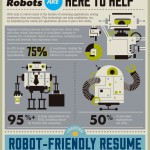And how to please them.
When I saw this article I was excited to share it with the architects and designers that apply to Consulting for Architects! We ask for a few things to represent you, in the best light possible to our customers, including a professionally written resume and your digital portfolio. The first thing we do with your resume is scan it for your contact information and keywords; also known as skills. Sure, this helps us save time creating your file in our database and that’s important – but the real advantage to having a resume crafted to maximize the “robots” accuracy reading your resume. This insures your name will surface above others when we use our automated search function to fill a job opening – as matching your skills is the desired outcome. The rest we leave to our experience as exclusive recruiters to the architecture and design profession and our personal interview, which garners your professional history and current career goals. So when you hear the experts say don’t use your resume to express your creativity, there’s a good reason – THE ROBOTS CAN’T READ IT!
Recruiting technology, like the increasingly prevalent applicant tracking system (ATS), is making it easier and faster for job-seekers to find and apply to their ideal employment opportunities. Talent acquisition professionals also appreciate the multiple benefits of an ATS, one of which is reducing the burden of reading hundreds, if not thousands, of resumes to find the right candidate for a position.
Candidates and recruiters, however, have reported some frustrations with ATSs, blaming them for screening out candidates who are seemingly well-suited for an open position. While it’s easy to make technology a scapegoat, keep in mind this software is simply doing what it was designed to do. The real culprit for the so-called “black hole” of applicant screening technology isn’t the ATS itself, but rather outdated rules for creating a resume.
This old guidance was based on a human being scanning through a pile of resumes, but now robust software performs that task. So rules that were originally designed for human eyes need to be re-thought with technology-based scanning in mind.
It’s time for a real paradigm shift in how we tell job-seekers to write their resumes—rules that will help candidates and opportunities connect in more powerful, easier ways.
CLICK ON THE INFOGRAPHIC THAT SAYS IT ALL!
Hat tip to HireRight










No comments so far!